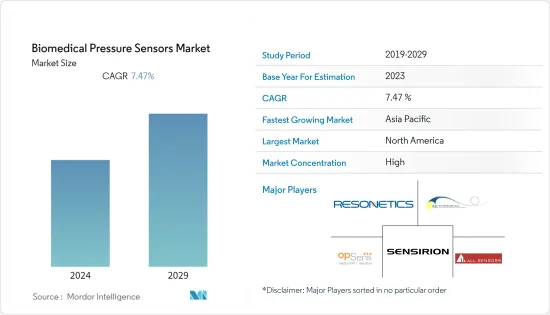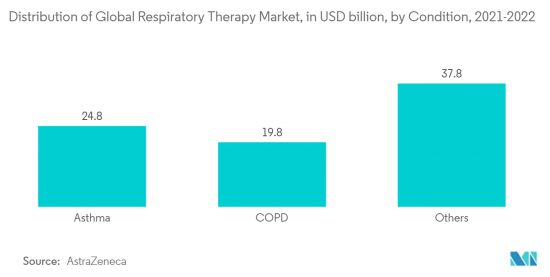 |
市場調査レポート
商品コード
1403076
生体用圧力センサー-市場シェア分析、産業動向・統計、2024~2029年成長予測Biomedical Pressure Sensors - Market Share Analysis, Industry Trends & Statistics, Growth Forecasts 2024 - 2029 |
||||||
● お客様のご希望に応じて、既存データの加工や未掲載情報(例:国別セグメント)の追加などの対応が可能です。 詳細はお問い合わせください。
| 生体用圧力センサー-市場シェア分析、産業動向・統計、2024~2029年成長予測 |
|
出版日: 2024年01月04日
発行: Mordor Intelligence
ページ情報: 英文 120 Pages
納期: 2~3営業日
|
- 全表示
- 概要
- 目次
生体用圧力センサー市場は前年度9,748億1,000万米ドルで、予測期間にはCAGR 7.47%で成長し、1兆4,730億米ドルに達する見込みです。

主要ハイライト
- 生体用圧力センサーは、圧力信号を測定可能な電気信号に変換する特殊な電子機器です。これらのセンサーは、さまざまな医療診断と治療機器や器具の重要なコンポーネントです。長年にわたり、センサー技術は大幅に進化し、高度な医療機器にこれらのセンサーが組み込まれるようになりました。さらに、小型化され、携帯可能でありながら効果的な医療機器の開発も促進されています。
- 生体用圧力センサーは、広範な状態において信頼性の高い診断を提供することで、患者の状態をモニターすることができます。これには、酸素濃縮器における酸素療法の有効性のモニタリング、輸液ポンプにおける適切な量と速度の輸液による薬剤注入の自動化、あるいは血圧の測定などが含まれます。
- この市場の成長を促進する重要な要因は、消費者の意識の高まりと世界の医療支出の増加に起因する、患者ケアの強化に対する需要の高まりです。例えば、経済協力開発機構(OECD)によると、2022年のGDPに占める医療支出の割合では、米国(16.6%)がトップで、ドイツ(12.7%)、フランス(11.9%)、日本(11.5%)などの国々がこれに続いています。
- 医療支出の増加は、圧力センサーが広く応用されている先進医療機器や医療インフラへの投資にプラスの影響を与えるため、医療支出の増加は調査市場の成長にプラスの影響を与えると予想されます。
- しかし、センサーの検出能力や読み取り値に対する環境の影響など、生体用圧力センサーーの技術的な限界は、調査した市場の成長に対する主要な抑制要因の1つとして残っています。さらに、特に新興国市場における製品の差別化や認知度の向上、センサーのコストなども市場成長の課題となっています。
- COVID-19の世界の流行は、特に携帯用と個人用セグメントにおける高度医療機器への需要が大きく伸びたため、調査市場の成長に大きな影響を与えました。このような動向は、サプライチェーンの混乱などの問題にもかかわらず、生体用圧力センサーの市場需要を維持しました。COVID-19後は、パンデミックによって世界的に医療産業の欠点が浮き彫りになり、利害関係者の注目を集め、医療産業への投資が促進され、調査した市場にビジネスチャンスが生まれると予想されるため、調査した市場にとっても有望と思われます。
生体用圧力センサー市場動向
大きな成長を確認する治療用用途
- 胸部理学療法機やネブライザーなど、いくつかの治療機器には圧力センサーが使用されています。ネブライザーは圧縮空気を使用して、患者が吸入する薬剤の霧を作ります。圧力センサーは圧縮空気の流量を測定し、それに応じて調整することで、正確なドラッグデリバリーを実現します。これらの機械は、慢性閉塞性肺疾患(COPD)、喘息、嚢胞性線維症、喘息、その他の呼吸器疾患を治療するために設計されています。
- 胸部理学療法機は、高圧空気の噴出により肺の痰や痰を緩める。これらの機器の圧力センサーがジェットの圧力をモニターし、最適な治療効果が得られるように適宜圧力を調整します。
- 呼吸理学療法機器には、独立したアプリケーション、治療の完全なコントロール、使いやすさなど多くの利点があるため、日々の治療における患者のコンプライアンス向上に役立ち、呼吸理学療法機器の需要を高めています。
- さらに、革新的な呼吸器ドラッグデリバリーデバイスに対する需要の高まりと、患者集団におけるこれらのデバイスの採用の増加は、治療用途における生体圧力センサーの需要を促進します。
- 喘息やCOPDなどの呼吸器疾患の罹患率の増加は、治療機器に対する高い需要を生み出し、市場の成長をさらに後押ししています。AstraZeneca Annual Reportによると、世界の喘息治療市場は248億米ドルを生み出しました。Global Asthma Report 2022によると、10人に1人の子供が喘息症状を患っています。世界的に、喘息は障害とともに生きる年数の第24位、障害調整生存年数(DALYs)で測定した疾病負担の第34位の原因となっています。毎日1,000人以上が喘息で死亡しています。低・中所得国では、最悪の症例に不釣り合いに苦しんでいます。
- さらに、携帯型治療器具の普及により、圧力センサーの需要が高まっています。例えば、一般的に毎分1リットルで表される気流量は、圧力を測定し、既知の流体力学的原理を利用することで計算できます。

アジア太平洋が大きな成長を記録する見込み
- アジア太平洋の大きなシェアは、医療分野のアプリケーション分野の成長に起因しています。中国、韓国、インドなどの新興国における需要の高まりが、生体用圧力センサーーの需要増加に大きく貢献すると予測されています。
- アジア太平洋セグメントは予測期間中に高成長が見込まれます。成長を支える主要要因としては、医療インフラへの投資、研究・イノベーションセンター、政府プログラム、医療機器・デバイス市場を優遇する政策などが挙げられます。
- mヘルス製品における政府のイニシアチブの増加、センサー技術を搭載したスマートフォンやその他の電子機器の採用の増加、mヘルスにセンサーを導入するための官民参入企業による投資の急増、モノのインターネット(IoT)や先進技術の採用の増加などが市場を牽引しています。
- アジア太平洋市場は、慢性疾患の有病率の増加や医療用センサーに対する個人の意識の高まりなどの要因により、成長が見込まれています。これらの地域における生体用圧力センサーー市場の成長は、近年医療用センサーの市場開拓が重視されるようになったこと、医療インフラが強化されたこと、病気の早期発見が可能になったことに起因しています。
- 中国における政府投資の増加は、同国の医療機器市場を後押しし、調査対象市場にとって有利な成長機会をさらに生み出すでしょう。例えば、2022年9月、中国政府は医療施設、大学、公共施設に医療機器のアップグレードを奨励するため、1兆7,000億人民元(2,464億米ドル)の融資優遇政策を発表しました。
生体用圧力センサー産業概要
センサー業界は、メーカー数が限られているため、予測期間中に大きな競合課題に直面すると予想されます。Resonetics LLC、RJC Enterprises LLC、All Sensors Corporation、Opsens Inc.などの市場リーダーが市場全体に大きな影響力を及ぼしています。これらの企業は、市場拡大や買収に注力することで事業を拡大してきました。しかし、市場の需要に合致した製品を開発する能力は限られており、その結果、新製品の発売や技術的なアップグレードが減少し、センサー分野全体の成長に影響を及ぼしています。技術革新による持続可能な競争優位性という点では、生体用圧力センサーーを開発する参入企業の数が比較的少ないため、センサー市場は他の産業に追いつく必要があり、その結果、市場は適度に統合されています。
2023年 8月、LCSCはSensirionとの提携を発表しました。この提携により、LCSCの顧客基盤が拡大し、市場での地位が確固たるものになると期待されています。
2023年4月、Superior Sensor Technologyは医療用人工呼吸器専用に設計された生体用圧力センサーを発表しました。これらのセンサーはオーバーサンプリング技術を取り入れ、ダイナミックレンジを大幅に向上させています。この改善により、機械式人工呼吸器は、センサー後のオーバーサンプリング処理を必要とせずに、センサー出力を直接利用できるようになります。
その他の特典:
- エクセル形式の市場予測(ME)シート
- 3ヶ月間のアナリストサポート
目次
第1章 イントロダクション
- 調査の前提条件と市場定義
- 調査範囲
第2章 調査手法
第3章 エグゼクティブサマリー
第4章 市場洞察
- 市場概要
- 業界の魅力度-ポーターのファイブフォース分析
- 供給企業の交渉力
- 買い手の交渉力
- 新規参入業者の脅威
- 代替品の脅威
- 競合の程度
- 圧力マッピングシステム概要
第5章 市場力学
- 市場促進要因
- 低コスト、高性能、高信頼性のセンサーへの需要の高まり
- 患者ケアの強化に対する需要
- 市場抑制要因
- センサーへの環境影響
- 製品差別化の欠如
第6章 市場セグメンテーション
- 技術別
- セルフキャリブレーション
- 光ファイバー
- テレメトリック
- 静電容量式
- ワイヤレスパッシブ
- ピエゾ抵抗
- 用途別
- 診断用
- 治療用
- メディカルイメージング
- モニタリング
- フィットネス&ウェルネス
- その他の用途
- 地域別
- 北米
- 欧州
- アジア太平洋
- ラテンアメリカ
- 中東・アフリカ
第7章 競合情勢
- 企業プロファイル
- Resonetics LLC
- RJC Entreprises LLC
- All Sensors Corporation(Amphenol Corporation)
- Opsens Inc.
- Sensirion Holding AG
- Merit Medical Systems Inc.
第8章 投資分析
第9章 市場の将来

The biomedical pressure sensors market was valued at USD 974.81 billion the previous year and is expected to grow at a CAGR of 7.47%, reaching USD 1.473 trillion over the forecast period.
Key Highlights
- Biomedical pressure sensors are special electronic devices that may transduce pressure signals into measurable electric signals. These sensors are the critical component in various medical diagnostic and therapeutic equipment and instruments. Over the years, sensor technology has evolved significantly, leading to the incorporation of these sensors in advanced medical devices. Moreover, this has also facilitated the development of miniaturized and portable yet effective medical devices.
- Biomedical pressure sensors may monitor a patient's condition by providing reliable diagnostics in a broad range of conditions. This may include monitoring oxygen therapy effectiveness in oxygen concentrators, automating drug infusion by administering the correct volume and rate of fluid in infusion pumps, or even measuring blood pressure.
- A significant factor driving the growth of the market studied is the growing demand for enhanced patient care, which results from growing consumer awareness and increasing healthcare expenditure globally. For instance, according to the Organisation for Economic Co-operation and Development (OECD), in 2022, the United States (16.6%) was the leading country in terms of healthcare expenditure as a percentage of GDP, followed by countries such as Germany (12.7%), France (11.9%), and Japan (11.5%), among others.
- As higher healthcare expenditure positively influences investments in advanced medical devices and medical infrastructure wherein pressure sensors widely find their application, the growing healthcare expenditure is anticipated to positively influence the studied market's growth.
- However, the technical limitations of biomedical pressure sensors, such as the environmental influence on the detection capabilities and reading of the sensor, remain among the major restraining factors for the studied market's growth. Additionally, the need for product differentiation and awareness, especially in the developing regions, as well as the cost of the sensors, also challenges the studied market's growth.
- The global outbreak of COVID-19 had a major impact on the growth of the studied market as the demand for advanced medical devices, especially in the portable and personal use segment, grew significantly. Such trends, despite issues such as supply chain disruptions, held the market demand for biomedical pressure sensors intact. The post-COVID-19 period also appears promising for the studied market as the pandemic highlighted the shortcomings of the healthcare industry globally, driving the attention of the industry stakeholders, which is expected to drive investments in the healthcare industry, creating opportunities in the market studied.
Biomedical Pressure Sensors Market Trends
Therapeutic Applications to Witness Major Growth
- Several therapeutic devices, such as chest physiotherapy machines and nebulizers, use pressure sensors. A nebulizer uses compressed air to create a mist of medication the patient inhales. A pressure sensor measures the compressed air flow rate and adjusts accordingly to ensure accurate drug delivery. These machines are designed to treat chronic obstructive pulmonary disease (COPD), asthma, cystic fibrosis, asthma, and other respiratory disorders.
- Chest physiotherapy machines use jets of high-pressure air to loosen phlegm and phlegm from the lungs. A pressure sensor in these devices monitors the pressure of the jet and adjusts the pressure accordingly for optimal therapeutic effect.
- Respiratory physiotherapy equipment offers many advantages, such as independent application, complete control of treatment, and ease of use, thus helping to improve patient compliance in daily treatment, thus increasing the demand for respiratory physiotherapy equipment.
- Furthermore, the growing demand for innovative respiratory drug delivery devices and the increasing adoption of these devices among the patient population will propel the demand for biomedical pressure sensors in therapeutic applications.
- The increasing incidence of respiratory diseases such as asthma and COPD is creating a high demand for therapeutic devices, further supporting the market growth. As per the AstraZeneca Annual Report, the global asthma therapy market generated USD 24.8 billion. According to the Global Asthma Report 2022, 1 in 10 children have asthma symptoms. Globally, asthma is the 24th leading cause of years lived with disability and the 34th leading cause of the burden of disease, as measured by disability-adjusted life years (DALYs). More than 1,000 people die every day from asthma. Low- and middle-income countries suffer disproportionately from the worst cases.
- Moreover, the growing adoption of portable therapeutic devices has increased the demand for pressure sensors. For instance, airflow rates, which are typically expressed in liters per minute, can be calculated by measuring pressure and using known fluid dynamic principles.

Asia-Pacific is Expected to Register Significant Growth
- The major share in the Asia-Pacific region can be attributed to the growth in application areas of the healthcare sector. It is predicted that the escalating demand in emerging economies, such as China, South Korea, and India, will greatly contribute to the rising demand for biomedical pressure sensors.
- The Asia-Pacific segment is expected to witness high growth during the forecast period. Major factors supporting the growth include investments in medical infrastructure, research and innovation centers, government programs, and policies favoring the healthcare equipment and devices markets.
- The market is driven by an increase in government initiatives in mHealth products, a rise in the adoption of smartphones and other electronic devices with sensor technology, a surge in investment by public and private players to introduce sensors in mHealth, and an increase in adoption of Internet of Things (IoT) and advanced technologies.
- The Asia-Pacific market is anticipated to experience growth, owing to factors such as the increasing prevalence of chronic disorders and the rising awareness of medical sensors among individuals. The growth of the biomedical pressure sensors market in these regions is attributed to the increased emphasis on the development of medical sensors in recent years, the enhancement of healthcare infrastructure, and the early detection of diseases.
- The rising government investments in China will boost the country's medical device market, further creating lucrative growth opportunities for the market studied. For instance, in September 2022, the Government of China announced a loan incentive policy of CNY 1.70 trillion (USD 246.40 billion) to encourage medical facilities, universities, and public buildings to upgrade their medical equipment.
Biomedical Pressure Sensors Industry Overview
The sensor industry is anticipated to face significant competitive challenges during the forecast period due to the limited number of manufacturers. Market leaders, including Resonetics LLC, RJC Enterprises LLC, All Sensors Corporation, and Opsens Inc., among others, exert considerable influence on the overall market. These companies have expanded their operations by focusing on market expansion and acquisitions. However, their ability to develop products that align with market demands has been limited, resulting in fewer new product launches and technological upgrades, which in turn affects the overall growth of the sensor sector. In terms of sustainable competitive advantage through innovation, the sensor market needs to catch up to other industries due to the relatively small number of players developing biomedical pressure sensors, resulting in a moderately consolidated market.
In August 2023, LCSC announced a collaboration with Sensirion aimed at providing enhanced solutions to customers through Sensirion's high-quality products. This partnership is expected to expand LCSC's customer base and solidify its position in the market.
In April 2023, Superior Sensor Technology introduced biomedical pressure sensors specifically designed for medical ventilators. These sensors incorporate over-sampling techniques to significantly enhance their dynamic range. This improvement enables mechanical ventilators to directly utilize sensor outputs without the need for post-sensor over-sampling processes.
Additional Benefits:
- The market estimate (ME) sheet in Excel format
- 3 months of analyst support
TABLE OF CONTENTS
1 INTRODUCTION
- 1.1 Study Assumptions and Market Definition
- 1.2 Scope of the Study
2 RESEARCH METHODOLOGY
3 EXECUTIVE SUMMARY
4 MARKET INSIGHTS
- 4.1 Market Overview
- 4.2 Industry Attractiveness - Porter's Five Forces Analysis
- 4.2.1 Bargaining Power of Suppliers
- 4.2.2 Bargaining Power of Buyers
- 4.2.3 Threat of New Entrants
- 4.2.4 Threat of Substitutes
- 4.2.5 Degree of Competition
- 4.3 Overview of Pressure Mapping Systems
5 MARKET DYNAMICS
- 5.1 Market Drivers
- 5.1.1 Growing Demand for Low-cost, High Performance, and Reliable Sensors
- 5.1.2 Demand for Enhanced Patient Care
- 5.2 Market Restraints
- 5.2.1 Environmental Impact on Sensors
- 5.2.2 Lack of Product Differentiation
6 MARKET SEGMENTATION
- 6.1 By Technology
- 6.1.1 Self-calibrating
- 6.1.2 Fiber-optic
- 6.1.3 Telemetric
- 6.1.4 Capacitive
- 6.1.5 Wireless Passive
- 6.1.6 Piezoresistive
- 6.2 By Application
- 6.2.1 Diagnostic
- 6.2.2 Therapeutic
- 6.2.3 Medical Imaging
- 6.2.4 Monitoring
- 6.2.5 Fitness and Wellness
- 6.2.6 Other Applications
- 6.3 By Geography
- 6.3.1 North America
- 6.3.2 Europe
- 6.3.3 Asia Pacific
- 6.3.4 Latin America
- 6.3.5 Middle East and Africa
7 COMPETITIVE LANDSCAPE
- 7.1 Company Profiles
- 7.1.1 Resonetics LLC
- 7.1.2 RJC Entreprises LLC
- 7.1.3 All Sensors Corporation (Amphenol Corporation)
- 7.1.4 Opsens Inc.
- 7.1.5 Sensirion Holding AG
- 7.1.6 Merit Medical Systems Inc.
